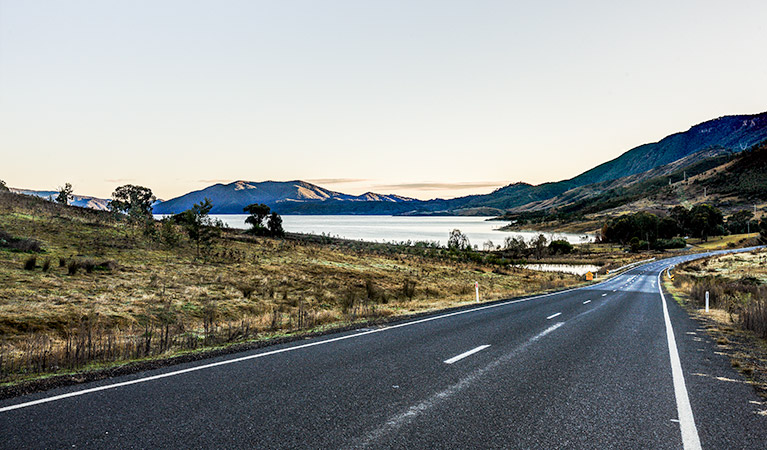Tumut area
Kosciuszko National Park
Overview
The Tumut area is your launch pad into northern Kosciuszko National Park. Discover water sports and wildlife at Blowering Reservoir. Camp and explore hidden walks and waterfalls in the foothills of the Snowy Mountains.
Read more about Tumut area
Tumut Visitor Centre is the ideal introduction to the diverse attractions, scenery and activities of northern Kosciuszko National Park.
Blowering Reservoir's sparkling waters are a drawcard for boating, sailing and waterskiing. Camp by the water, throw a fishing line in and see if the cod or redfin are biting, and be sure to bring your canoe or kayak for a paddle.
Spot kangaroos, emus, and maybe even an eagle, from your campground or picnic spot on Blowering’s eastern shores. Head off the beaten track to secluded Buddong Falls campground, near Tumbarumba.
The tall forests hide shady tracks and trails to secret waterfalls and panoramic lookouts. Walk to pretty Buddong Falls, or climb to the base of Blowering Cliffs. Hike along Old Mountain Road, or discover Landers Falls lookout, perched above a rocky gorge. Nearby, Big Talbingo trail is a challenge for both mountain bikers and walkers.
Most attractions are easily accessed along the Snowy Mountains Highway. This scenic drive runs 180km from Tumut to Cooma, via Talbingo and Adaminaby. You could even make a day of it, and take in Yarrangobilly.
Local alerts
For the latest updates on fires, closures and other alerts in this area, see https://www.nationalparks.nsw.gov.au/visit-a-park/parks/tumut-area/local-alerts
Map
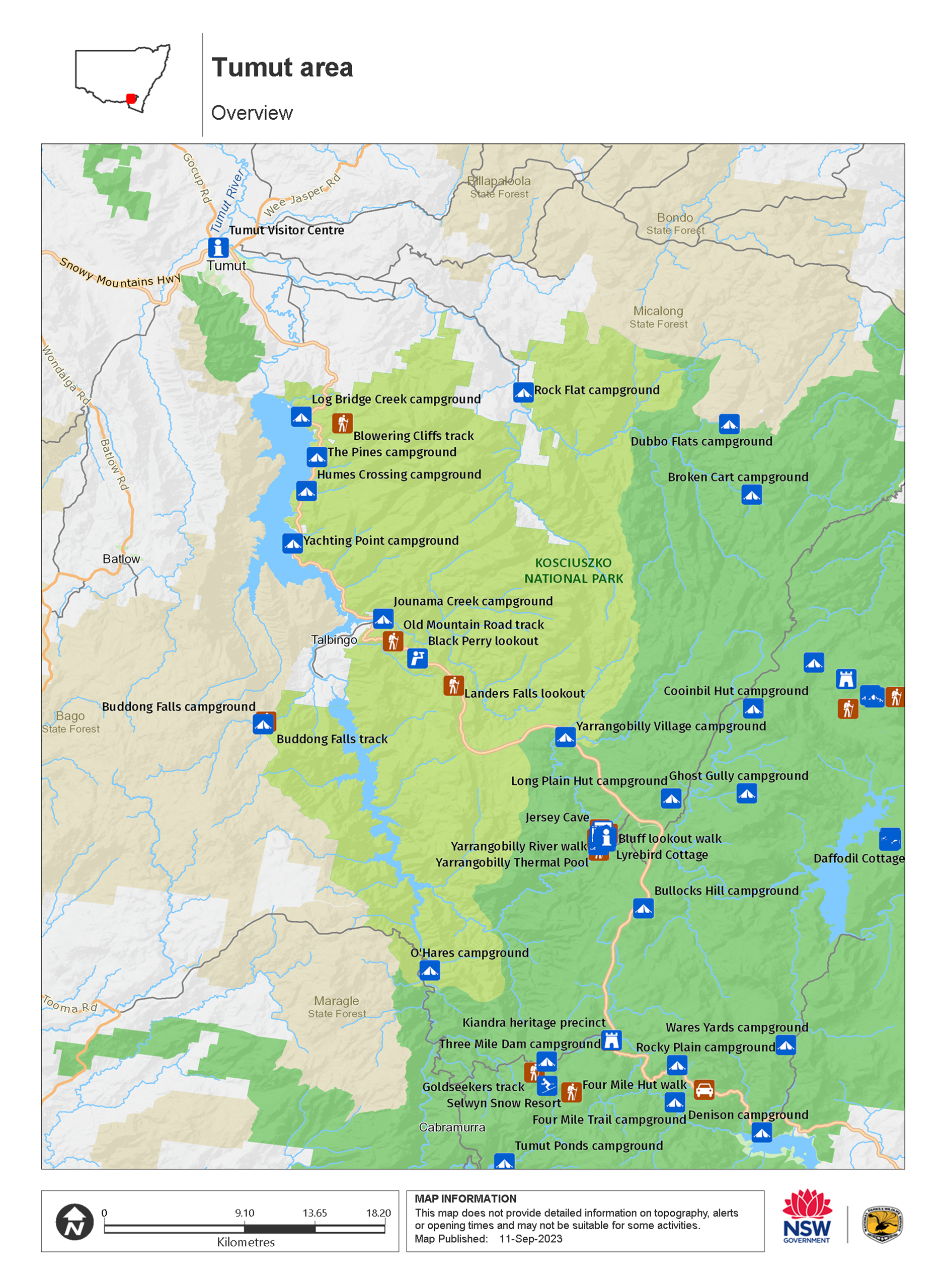
Map legend

Contact
- in Kosciuszko National Park in the Snowy Mountains region
The Tumut area is open all year but some roads and trails may close due to weather conditions or park management issues.
-
No park entry fees apply in the Tumut area. See vehicle entry fees for other areas in Kosciuszko National Park.
Buy annual pass. -
-
Tumut Region Visitor Centre
02 6947 7025
Contact hours: 9am to 5pm daily. Closed Christmas Day. - The Old Butter Factory, 5 Adelong Road, Tumut NSW 2720
-
Email: tumutrvc@environment.nsw.gov.au
-
Tumut Region Visitor Centre
Visitor info
All the practical information you need to know about the Tumut area.
Getting there and parking
Get driving directions
To get to attractions in the Tumut area of Kosciuszko National Park:
From Hume Highway via Tumut:
- From Sydney, take the Gundagai exit and follow Gocup Road to Tumut
- From Albury or Wagga Wagga, take Snowy Mountains Highway via Adelong to Tumut
- Drive south along Snowy Mountains Highway to the park boundary
From Cooma:
- Travel west through Cooma for 7km
- Turn right at the signs to Tumut and follow Snowy Mountains Highway
- Tumut is around 185km from Cooma, Talbingo is around 150km
From Tumbarumba:
- Take Tooma Road and Elliott Way
Parking Show more
- Black Perry lookout See on map
- Buddong Falls campground See on map
- Buddong Falls walking track See on map
- Humes Crossing campground See on map
- The Pines campground See on map
- Tumut Visitor Centre See on map
- Yachting Point campground See on map
Road quality
Snow chains
The Roads and Maritime Service (RMS) recommends snow chains are carried by all vehicles driving in the park in winter, including 4WD and AWD, in the event of extreme weather. Visit the Live Traffic website for current conditions.
Best times to visit
The Tumut area has plenty of things to do and see. Here are some of the highlights:
Autumn
The blue skies and crisp weather are perfect for outdoor activities. Get on your bike and tackle Cumberland and Big Talbingo trails, in the hills above Talbingo. Take a long walk or scenic drive, and enjoy freshly-caught fish by the campfire at tranquil Buddong Falls, O’Hares, or Jounama Creek campground. Aside from the roos, possums and wombats, you might have the place to yourself.
Spring
With spring rains the waterfalls will be flowing, though take care on tracks which can be boggy. Birdwatchers will be kept busy spotting honeyeaters, firetails, parrots and raptors, including wedge-tailed eagles. Snowmelt fills mountain streams and reservoirs, so cast your fishing line, or get out on the water to explore by paddle power.
Summer
Set up camp at Humes Crossing or The Pines campground by Blowering Reservoir and spend your days paddling, sailing, swimming and fishing. Escape the heat with a shady forest walk along Blowering Cliffs track, Warogong Sugarloaf walk, or Old Mountain Road, as purple kunzea and white-flowered tea tree bloom on the lower slopes. Ask the Tumut Visitor Centre about ranger-led tours during school holidays.
Facilities
Toilets Show more
- Buddong Falls campground
- Buddong Falls walking track
- Humes Crossing campground
- Jounama Creek campground
- The Pines campground
- Tumut Visitor Centre
- Yachting Point campground
Picnic tables Show more
- Buddong Falls campground
- Buddong Falls walking track
- Humes Crossing campground
- Jounama Creek campground
- O'Hares campground
- The Pines campground
- Yachting Point campground
Barbecue facilities Show more
Boat ramp
Maps and downloads
Fees and passes
No park entry fees apply in the Tumut area. See vehicle entry fees for other areas in Kosciuszko National Park.
Annual passes and entry fees (https://www.nationalparks.nsw.gov.au/passes-and-fees)
Permitted
Cycling
Cycling is permitted on public roads, and on management trails outside wilderness areas. Riders please give way to walkers.
Fishing
You can fish in rivers and streams between the October and June long weekends. A current NSW recreational fishing licence is required to fish in all waters. Fishing in dams and lakes is permitted year-round, but some waterways may close temporarily or have restrictions. Refer to the NSW Recreational Freshwater Fishing Guide for information.
Prohibited
Firearms, chainsaws and fossicking are not permitted in Kosciuszko National Park.
Drones
Flying a drone for recreational purposes is prohibited in this area. Drones may affect public enjoyment, safety and privacy, interfere with park operations, or pose a threat to wildlife. See the Drones in Parks policy.
This area may be a declared Drone Exclusion Zone, or may be subject to Civil Aviation Safety Authority (CASA) rules for flying near airports, aerodromes and helicopter landing sites. See CASA's Drone Flyer Rules.
Commercial filming and photography
Commercial filming or photography is prohibited without prior consent. You must apply for permission and contact the local office.
Pets
Pets and domestic animals (other than certified assistance animals) are not permitted. Find out which regional parks allow dog walking and see the pets in parks policy for more information.
Smoking
NSW national parks are no smoking areas. The alpine resorts of Thredbo, Perisher, Charlotte Pass, Selwyn, Ski Rider and Kosciuszko Tourist Park are exempt, though some commercial and outdoor places within these resorts may have no smoking areas.
Visitor centre
-
Tumut Visitor Centre
The Old Butter Factory, 5 Adelong Road, Tumut NSW 2720 - 9am to 5pm daily. Closed Christmas Day.
- 02 6947 7025
Nearby towns
Talbingo (3 km)
Talbingo is surrounded by some of the most inspiring scenery in the Snowy Mountains. At Talbingo Dam you'll enjoy panoramic views of the region as well as superb fishing for brown and rainbow trout. You can even go water-skiing on the dam.
Tumut (12 km)
Tumut is a country town on the northern foothills of the Snowy Mountains. The Rolling valleys, mountain streams and alpine mountain ranges make it popular for nature lovers and adventure enthusiasts.
Learn more
Tumut area is a special place. Here are just some of the reasons why:
Explore by water, wheels or walking
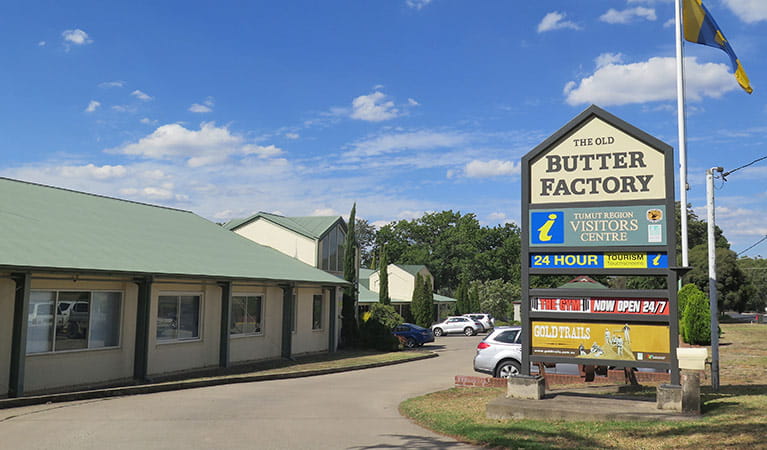
If you need some inspiration, stop by the Tumut Visitor Centre, for tips on top experiences, where to stay, and spot a corroboree frog in the display. Learn more about Kosciuszko National Park’s plants, animals and landscapes on an Aboriginal ranger-led tour (contact the visitor centre). Boat ramps on Blowering Reservoir, Talbingo Dam wall, and at O’Hares campground provide easy access for boating and paddling. There are also plenty of scenic drives, walking tracks and bike trails to tempt you away from the water. If you’re well-prepared, explore the remote Goobarragandra Wilderness or hike part of the 425km Hume and Hovell walking track.
- Black Perry lookout Black Perry lookout, near Talbingo Mountain in Kosciuszko National Park, offers scenic views over the Snowy Mountains region, and is close to Tumut and Yarrangobilly Caves.
- Tumut Visitor Centre Tumut Visitor Centre, on Snowy Mountains Highway, is the ideal starting point for a visit to northern Kosciuszko National Park, offering information, booking services, and souvenirs.
World-class wilderness
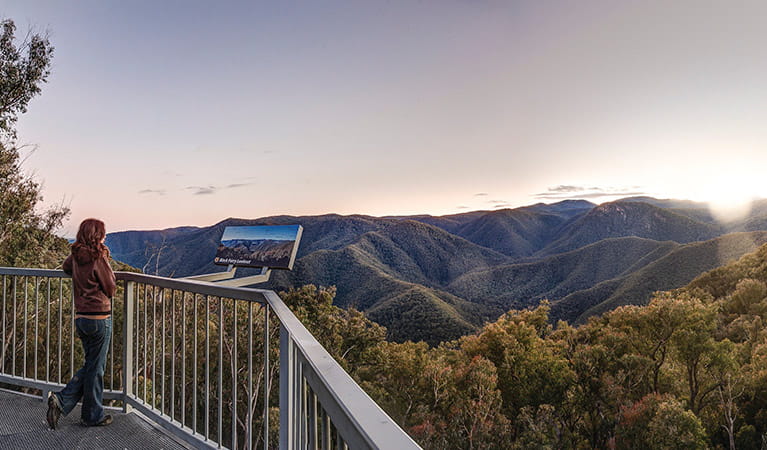
In recognition of Kosciuszko's unique value as a conservation area, it’s been named a UNESCO Biosphere Reserve. More than half of the park, over 350,000ha, has been declared wilderness, including the Bogong Peaks and Goobarragandra wilderness areas. Black Perry lookout is an excellent place to get a sense of the expansive wilderness areas in Kosciuszko's north.
Snowy Mountains history
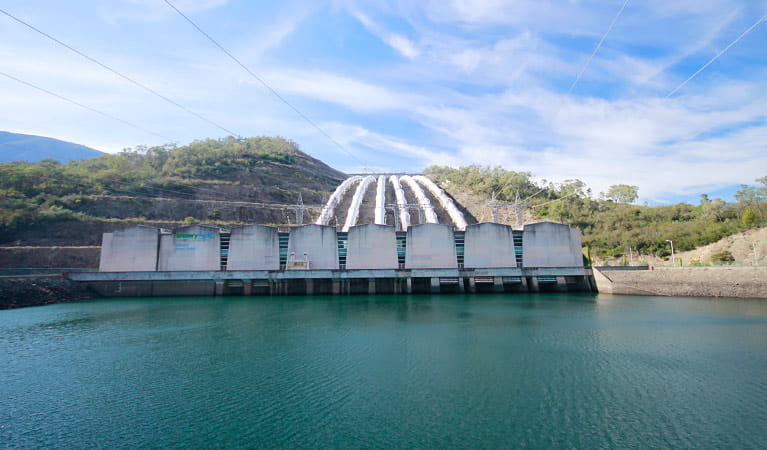
Tumut area’s more recent history can be seen at Blowering Reservoir, and just outside the park at Talbingo. The Snowy Hydro Scheme is recognised as one of the civil engineering wonders of the modern world. Its vast network of dams and power stations includes Blowering, Jounama and Talbingo reservoirs, and Tumut 3 Power Station, at Talbingo.
Unique landscapes
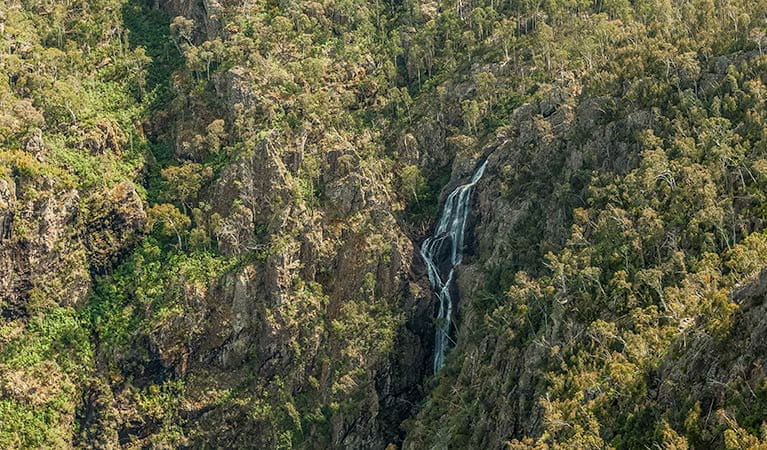
The change in scenery is noticeable as you drive along Snowy Mountains Highway. The road climbs over 1000m from the Tumut River Valley, through woodland of mountain gum and narrow-leaf peppermint, to the treeless plains surrounding Kiandra.
- Black Perry lookout Black Perry lookout, near Talbingo Mountain in Kosciuszko National Park, offers scenic views over the Snowy Mountains region, and is close to Tumut and Yarrangobilly Caves.
- Landers Falls lookout walk Landers Falls lookout walk, tucked into the forest between Tumut and Kiandra, wows you with dramatic views of Landers Creek waterfall plunging into the rocky gorge above Talbingo Reservoir.
Plants and animals protected in this park
Animals
-

Swamp wallaby (Wallabia bicolor)
The swamp wallaby, also known as the black wallaby or black pademelon, lives in the dense understorey of rainforests, woodlands and dry sclerophyll forest along eastern Australia. This unique Australian macropod has a dark black-grey coat with a distinctive light-coloured cheek stripe.
-
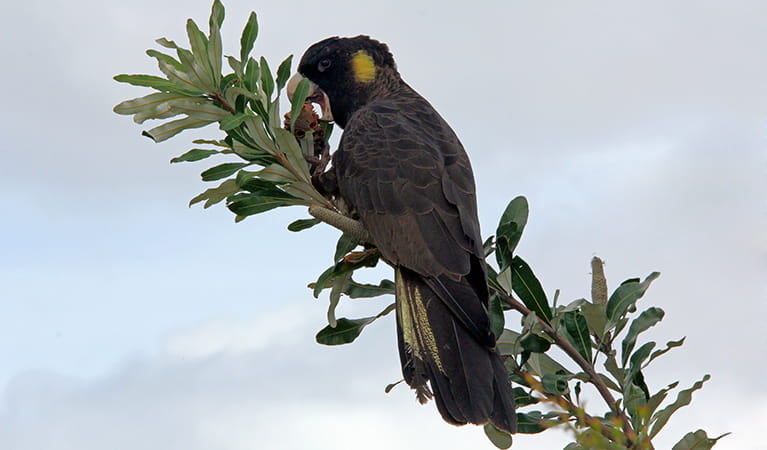
Yellow-tailed black cockatoo (Calyptorhynchus funereus)
The yellow-tailed black cockatoo is one of the largest species of parrot. With dusty-black plumage, they have a yellow tail and cheek patch. They’re easily spotted while bird watching, as they feed on seeds in native forests and pine plantations.
-
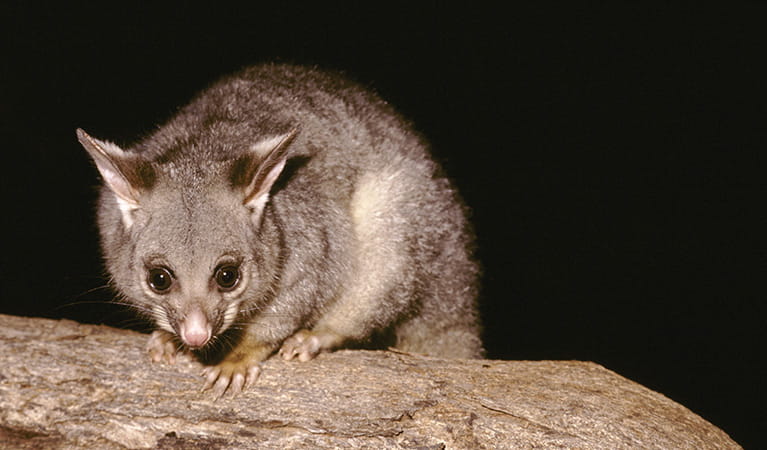
Common brushtail possum (Trichosurus vulpecula)
One of the most widespread of Australian tree-dwelling marsupials, the common brushtail possum is found across most of NSW in woodlands, rainforests and urban areas. With strong claws, a prehensile tail and opposable digits, these native Australian animals are well-adapted for life amongst the trees.
-

Common ringtail possum (Pseudocheirus peregrinus)
Commonly found in forests, woodlands and leafy gardens across eastern NSW, the Australian ringtail possum is a tree-dwelling marsupial. With a powerful tail perfectly adapted to grasp objects, it forages in trees for eucalypt leaves, flowers and fruit.
-

Bare-nosed wombat (Vombatus ursinus)
A large, squat marsupial, the Australian bare-nosed wombat is a burrowing mammal found in coastal forests and mountain ranges across NSW and Victoria. The only other remaining species of wombat in NSW, the endangered southern hairy-nosed wombat, was considered extinct until relatively recently.
-
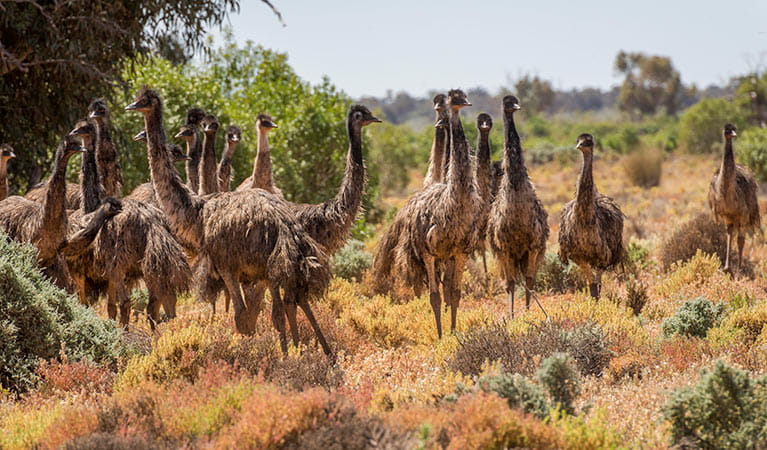
Emu (Dromaius novaehollandiae)
The largest of Australian birds, the emu stands up to 2m high and is the second largest bird in the world, after the ostrich. Emus live in pairs or family groups. The male emu incubates and rears the young, which will stay with the adult emus for up to 2 years.
-
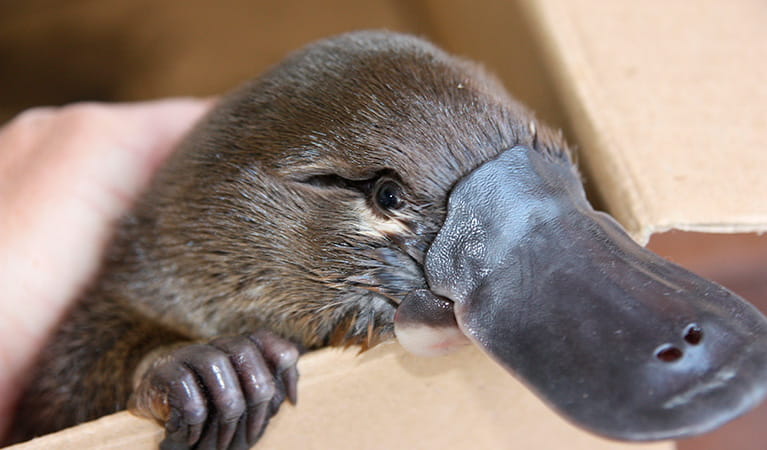
Platypus (Ornithorhynchus anatinus)
One of the most fascinating and unusual Australian animals, the duck-billed platypus, along with the echidna, are the only known monotremes, or egg-laying mammals, in existence. The platypus is generally found in permanent river systems and lakes in southern and eastern NSW and east and west of the Great Dividing Range.
-
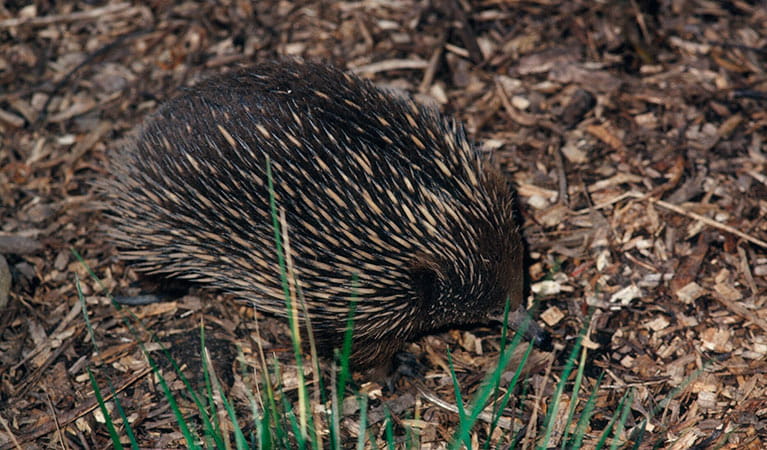
Short-beaked echidna (Tachyglossus aculeatus)
One of only 2 egg-laying mammals in the world, the short-beaked echidna is one of the most widespread of Australian native animals. Covered in spines, or quills, they’re equipped with a keen sense of smell and a tube-like snout which they use to break apart termite mounds in search of ants.
-

Superb lyrebird (Menura novaehollandiae)
With a complex mimicking call and an elaborate courtship dance to match, the superb lyrebird is one of the most spectacular Australian animals. A bird watching must-see, the superb lyrebird can be found in rainforests and wet woodlands across eastern NSW and Victoria.
-
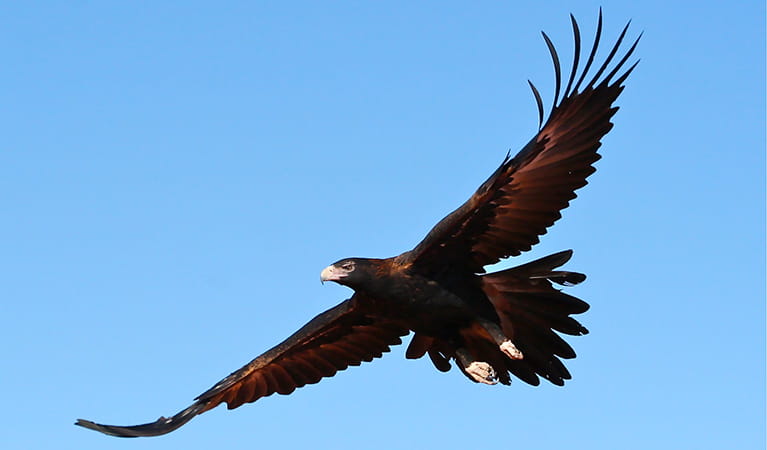
Wedge-tailed eagle (Aquila audax)
With a wingspan of up to 2.5m, the wedge-tailed eagle is Australia’s largest bird of prey. These Australian animals are found in woodlands across NSW, and have the ability to soar to heights of over 2km. If you’re bird watching, look out for the distinctive diamond-shaped tail of the eagle.
Environments in this area
School excursions (4)
- Aboriginal identity, Stage 3 (Years 5-6), History
- Aboriginal stories, Stage 1 (Years 1-2), History
- Aboriginal stories, Early Stage 1 (Kindergarten), History
- Aboriginal customs and practices, Stage 2 (Years 3-4), History
What we're doing
Tumut area has management strategies in place to protect and conserve the values of this park. Visit the OEH website for detailed park and fire management documents. Here is just some of the work we’re doing to conserve these values:
Understanding landscapes and geology
Geo conservation efforts play an important role in protecting the delicate ecosystems of Kosciuszko National Park. Rehabilitation and maintenance works to limit the impact of erosion and degradation, and monitoring the effects of climate change and visitation, are ongoing.
Preserving bioodiversity
Kosciuszko National Park plays an important role in conserving NSW’s biodiversity and preserving its vulnerable, threatened and endangered species. Conservation activities, such as the Saving Our Species and northern corroboree frog conservation programs, are carried out in this area of the park. These activities include monitoring the species’ habitats, distribution and population.
Managing weeds, pest animals and other threats
Pests and weeds have a significant impact on the ecosystems and habitats within Kosciuszko National Park. Reduction of pest species such as deer, pigs, dogs and foxes, is an important part of the work NSW National Parks and Wildlife Service (NPWS) does to protect the integrity of the Tumut area.
Developing visitor facilities and experiences
NPWS is committed to developing facilities for the enjoyment and safety of visitors to Kosciuszko National Park. Visitor feedback and environmental sustainability are key considerations in park maintenance, and upgrades are ongoing. Camping areas are continually maintained and upgraded, and NPWS regularly reviews the park’s recreational opportunities, identifying areas for improvement or addition. Hazard assessments are also ongoing.
Kosciuszko National Park has achieved Australia’s first Ecotourism Destination Certification, through Ecotourism Australia, recognising best practice sustainable tourism and visitation in protected areas.
Managing fire
NSW is one of the most bushfire prone areas in the world due to our climate, weather systems, vegetation and the rugged terrain. NPWS is committed to maintaining natural and cultural heritage values and minimising the likelihood and impact of bushfires via a strategic program of fire research, fire planning, hazard reduction, highly trained rapid response firefighting crews and community alerts.

